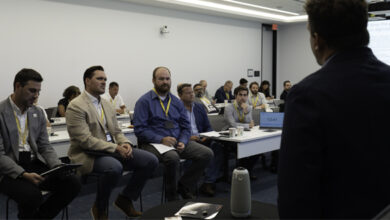Transocean develops hybrid power plant to improve dynamic load compensation, continue drawworks operation through power disruptions
By providing access to stored energy, Active Power Compensation system reduces fuel usage and emissions, improves process safety
By Yin Wu, Transocean
In every industrial power application, energy must be supplied to the process in a manner that does not limit performance. The energy supply must be capable of meeting the dynamic demands of the industrial process requirement. Whether it is a textile mill in China or a top drive on the latest mobile offshore drilling unit (MODU), performance requires that the energy be supplied as fast as the load demands. This drives the development of features on energy supplies to speed up response. On diesels, we see turbo chargers, jet air assist and electronic fuel injectors. With respect to load demand, designs try to limit aggressive power demand with features like flywheels, motor soft-starters and low-inertia machines.

With small, stand-alone power plants and aggressive hoisting loads, MODUs have always been challenged to balance the dynamic capability of the energy source and process load demands. From direct drive diesels to DC systems to the full AC electric systems, drilling vessels have continuously improved energy sources and load control to meet the ever increasing power demands of offshore drilling. The industry demands processes that can safely manage and recover oil reserves with higher pressures that are found deeper in the ocean. The size and efficiency of the diesels has been researched, and the ability of diesel to generate power simultaneous to the load demand is critical to the process being successful.
Objectives of the hybrid power plant
Two things have occurred to further challenge the balance between energy source and consumer. With respect to process loads, the drawworks, already the most aggressive load on the vessel, became even larger and more aggressive. With the advent of active heave compensation, not only a human operator but also the vessel motion dictates the movement of the blocks. When active heave compensation is engaged, the consequences of the drawworks not tracking movement command is more serious than slowing operations. Not tracking command can lead to failures, such as the buckling or parting of the drill string. In addition to the active heave, the total hookload necessary to meet the demands of a deepwater, high-pressure well have increased. This increase in criticality and capacity resulted in a reevaluation of the power plant performance. To meet these increased demands and modern drilling timetables, two drawworks were installed, both with active heave compensation. The two drawworks can operate in complete synchronism with vessel motion, doubling the dynamic demands on the power plant.
The second change relates to the vessel’s energy source – diesel electric generators. Market demands for fuel economy and highly predictable and reduced emissions have reduced the dynamic capability of modern diesels. Technologies, such as highly turbocharged intake air and precision fuel injection, greatly improve fuel economy at the cost of rapid response to power demands.
Figure 1, produced by a math model proven on Transocean’s newest drillships, graphically shows the machinery movement and the transfer of energy. It is now widely accepted that the drawworks must be capable of massive hookloads and move in synchronism with vessel motion.
The figure shows the power and total energy needed to achieve a simple ascent and descent of the traveling block. To achieve the smooth motion and steady speeds shown in the block height graph, very high and aggressive power peaks are needed. In addition, for most of the descent, the drawworks produces a negation power, which is dissipated into braking systems. The right side of the energy consumption graph shows that the total energy used to raise and lower the blocks is far less than the potential energy moved into and out of the block during the operation.
If the energy that is invested in the block’s potential (due to its height) could be recovered and reused, the diesel would need to provide only the small amount of energy lost to friction, shown on the right of the energy consumption graphic. Reusing the energy that is passed to the block and then recovered from the block directly is a more efficient use of energy. The diesel would now provide only the small amount of energy shown on the right side of the energy consumption graphic. The stored and reused energy would now provide the “bulk energy” that is moved between the block potential energy and the storage unit.
To address the dynamic capability of the diesel energy source, the technology used to store and deliver the energy must be able to deliver and absorb energy at a rate that is faster than the drawworks’ demand. With fuel efficiency and drawworks responsiveness as primary goals, it was prudent to develop the alternative energy storage for the main power plant.
Momentary loss of main power can cause the drawworks to shut down with an aggressive application of the brakes. This response is a necessary safety measure to prevent the blocks from free falling, but it causes a shock to the drill line that may damage and even part the line. The alternative energy storage is made available to the drawworks when the main power plant is experiencing a short circuit, is disabled, overloaded or disconnected from the drilling drives. This brings a step-change in operations. It prevents the sudden application of drawworks brakes due to electrical failure. Access to stored energy brings back the braking independence that existed with battery-powered brakes, removed in favor of full AC motor control of the drawworks. Further, having this energy available to shift the drill pipe during a disconnection or to continue heave compensation without dependence on the power plant allows for additional confidence in the emergency disconnect sequence.
The access to stored energy improves the operational risk profile of offshore drilling by mitigating some risk events. Any action that tilts risk management in a favorable direction can positively affect the commercial fundamentals of drilling.
The removal or reduction of power plant disturbances in the failure mode effects analysis allows the possibility of the drawworks use for long-term drill string tests. The inherent multi-motor fault tolerance of the drawworks was the common mode failure of the power plant. With a stored energy system, this common mode failure is removed. Further, the costs and challenges of a string or crown-mounted compensation are eliminated.
With respect to the market requirements for predictable and limited emissions, this solution removes the rapid and large cyclic loads on diesels, improving both fuel consumption and emissions.
The design philosophy
The addition of any new technology to a MODU must be fully vetted to make sure the addition does not introduce any new system failure modes. The control system for Transocean’s designed and patented Active Power Compensation hybrid system has three main tasks:
• Controlling the charge of the energy storage units;
• Dissipation of power into capacitors or into resistors to discharge the DC bus; and
• Safety functions, including turning off the system and the removal of energy from the energy storage units.
To simplify and remove single points of failure, the design must be autonomous and eliminate any centralized control. Failure of control or power circuits should affect only one energy storage unit, and the autonomous control removes the influence of other systems.

As shown in Figure 2, the cyclic loads from the drawworks are met with the combination of both diesel power and stored energy. For most operations, the energy storage units receive and deliver energy counter to the energy profile of the drawworks. The energy storage units are also available to deliver or consume energy to or from the main power bus, contributing to main power plant stability. The result is a decoupling of the cyclic loads from the drawworks and generators, providing a steadier load. As noted, this improves the maintenance, fuel and emission goals.
Design and performance considerations
The technique and technology designed and patented by Transocean meets the objectives defined above. Considerations included:
• Life span: Ultra-capacitors provide an acceptable cycle life, and energy is stored in an electric field, reducing losses compared with batteries;
• Fast response: Ultra-capacitors with the energy stored in an electric field provide fast response;
• Fault tolerance: The size of each independent energy storage unit allows potential failure with limited impact on the drawworks;
• Autonomy: The design allows full autonomy between energy storage units. This removes the unnecessary signaling;
• Size: The addition of the energy storage unit does not require additional power electronics in the drilling drive line-up. The energy storage units are mounted in a remote location from the line-ups, in the same way as the dynamic power braking resistors;
• Cost: By adding energy storage units and utilizing existing power electronics, cost is kept to a minimum;
• Diagnostics: The use of local controllers allows real-time diagnostics and monitoring;
• Testing: The design includes test functions;
• Protection: Local controllers allow electrical and thermal protection;
• Simplicity: There is no increase in complexity or additional maintenance training, software or special tools needed; and
• Predictability: Operational measurements, built-in test routines and real-time diagnostics assist with more predictable performance.
By building these considerations into the design, Transocean has met the design objectives to enhance conventional equipment used in the drilling process.
Impact of hybrid power plant on drill floor
The installation of the hybrid system has demonstrated that the design objectives are fully met. By running the drawworks with hybrid power enabled and disabled, the improvement of the dynamic load compensation can be measured. The ability to operate the drawworks through a power disruption has been tested and proven. With this proven capability, drilling process risks are reduced.
With this concept well demonstrated, the drilling industry should expect to see future applications toward improving drilling performance, reducing emissions and, most importantly, increasing process safety. DC
Active Power Compensation is a registered trademark of Transocean.
This article is based on a presentation at the 2016 IADC Advanced Rig Technology Conference, 13-14 September, Galveston, Texas.




